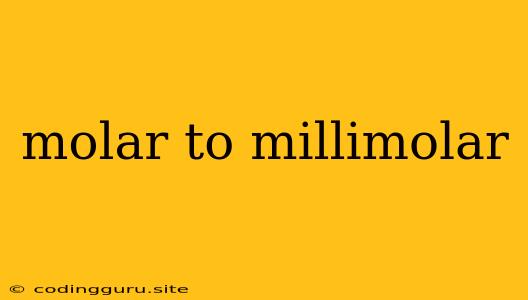Molar to Millimolar: Understanding the Conversion
In the realm of chemistry and related fields, concentration is a fundamental concept, and often expressed in terms of molarity (M). However, for practical purposes, working with millimolar (mM) units can be more convenient, especially when dealing with relatively dilute solutions. This article aims to demystify the conversion between molarity and millimolarity, providing a clear understanding of the relationship between these two units.
What is Molarity?
Molarity (M) is a measure of concentration that expresses the number of moles of a solute dissolved in one liter of solution. In simpler terms, it tells us how much solute is present in a given volume of solution.
What is Millimolarity?
Millimolarity (mM) is a unit of concentration that represents one-thousandth of a molar solution. It's essentially a smaller unit of measurement used to express the concentration of solutions where molarity would be too large a number to be practical.
How to Convert Molar to Millimolar
The conversion from molar (M) to millimolar (mM) is straightforward. You simply multiply the molar concentration by 1000:
mM = M x 1000
Example:
If a solution has a concentration of 0.5 M, its equivalent millimolar concentration would be:
mM = 0.5 M x 1000 = 500 mM
Understanding the Conversion: A Practical Example
Imagine you have a stock solution of a reagent with a concentration of 1 M. You need to prepare a working solution with a concentration of 50 mM. To do this, you would need to dilute the stock solution. The conversion from molar to millimolar is essential to calculate the correct dilution factor.
1. Convert the desired concentration from millimolar to molar:
- 50 mM / 1000 = 0.05 M
2. Determine the dilution factor:
- Dilution factor = Stock solution concentration / Desired concentration
- Dilution factor = 1 M / 0.05 M = 20
3. Dilute the stock solution:
- To prepare the 50 mM working solution, you would take 1 part of the 1 M stock solution and add 19 parts of solvent (e.g., water).
Why is this Conversion Important?
Understanding the relationship between molarity and millimolarity is crucial for many reasons:
- Accurate Calculations: Using the correct unit ensures accurate calculations in chemical reactions, dilutions, and various analytical techniques.
- Convenience: Working with millimolar units is often more practical, especially for dilute solutions where molarity would result in very small numbers.
- Interchangeability: Understanding the conversion allows you to seamlessly switch between molar and millimolar units as needed.
Conclusion
Converting between molar and millimolar is a simple yet fundamental skill in chemistry and related disciplines. It allows for accurate calculations, convenient expressions of concentration, and smooth transitions between units. By grasping the basic principles of this conversion, you can navigate the world of solutions and chemical reactions with confidence.
